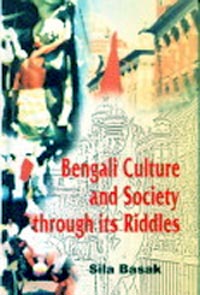Dec 10, 2025
Dec 10, 2025
Presented in English, Bengali Culture and Society through its Riddles, a translation from dialects of Bengali, the riddles are so chosen for non-Bengali readers to relate to. An emotive metaphor with a question is how a riddle is defined, most often used as a form of entertainment, to exercise and challenge the intellect, instructive in nature, at the same time, confuses and contradicts, at times absurd and is brief. Its form can be blank verse, rhymes or in prose. Its subject is from nature to daily chores. The Bengali riddle covers rites and rituals. Language used to express riddles is often redundant, ornamental, or in rhyme form. Its meaning is concealed, to be found through clues. The distinction between a rhyme and a riddle is that the aim of the former is to create music whereas the latter is to create meaning. Literary Riddle Just as language varies across geographic settings, so also riddles vary. Each culture defines the nature of riddles. 'Bengali riddles are characterized by its people, nature, birds and animals, customs, articles of daily use, etc' (p.27). A literary riddle emerges from the popular riddle and is made elegant in terms of language, is longer and is obscure. For example, the popular riddle is Ek kole dui bhai Two brothers on the same lap An example of the literary riddle is Taru nay bane ray nahi dhare phul Lives in forests, not a tree nor hold flowers The answer is, 'forest fire' (p31) Popular Riddle This chapter renders, riddles in great detail, and is so interesting and resourceful. For example: The Garlic Tree Matir nice thake budi Old woman underground Rural Life in Riddles he Mymensingh riddle is most picturesque: Akas theke namlo budi katha kambal laiya Fan Sutkale deyni dekha Larger Social Life and Riddles What is the news? The answers were: Sun and its ways The riddle on page 163 about the 'egg' is presented from across the world is also of interest. Comparative study This section focuses on comparisons of riddles across regions in India which are similar to and different from the ones in Bengal. There are a few from across the world. The Rajbansis and Bengalis perceive the 'jackfruit' as an 'Old person with boils all over' while the Santhals perceive the fruit as 'sweet rash' instead of 'boils. So also the riddle for 'eye' varies ' in 24 Parganas ' it is 'Two brothers in the same courtyard ' none can see the other'. Among the Gonds it is 'An old woman keeps opening and shutting the doors' and in Orissa it is 'Two brothers stay separately in the same house'.
 Riddles are specific to socio-cultural settings. It is shared and enjoyed amidst a social gathering. This volume has Bengali riddles collected over a period of two decades from Parts of West Bengal and Bangladesh.
Riddles are specific to socio-cultural settings. It is shared and enjoyed amidst a social gathering. This volume has Bengali riddles collected over a period of two decades from Parts of West Bengal and Bangladesh.
Keur sathe keur dekha nai
One does not meet the other
Dal pallav tar ati se bipul
Pabane karia bhar karay bhraman
Banete thakia kare baner dosan
Branches are huge
Travels on wind
Lives in forest and destroys it too
Popular riddles are part of the stream of oral culture. These cover deities and human beings, nature, domestic life, birds, animals and insects, musical instruments, stories, fables, numbers, etc.
Kapad pare tin kudi Wears three and twenty clothes
Dhopay kapad nay na Washer man does not wash
Tabuo kapad mayla hay na Yet clothes never get dirty.
Rituals observed to appease nature is what this section is all about. Seasons of the year, on which agriculture is dependent, often plays on the nerves of farmers. This section is very interesting:
Rain
Sei budi katha kay nirabe basiya
From the sky comes old woman with belongings
That woman talks sitting silently
Grishmakale praner sakha
Does not appear in winter
Bosom pal in summer
The famous conversation between Yudisthira and the Yaksa in the Mahabharata is interesting. The questions were:
What is most strange?
What is the way?
Who is happy?
Death is inevitable yet people crave for immortality
The way is of great men
He who cooks a little 'sag' for himself in the evening
Social Analysis
Riddles, an oral art form, used among the working class are one form of entertainment. It provokes the intelligence and the power of judgment of a people and is resourceful in retaining the inquisitiveness of human mind considered a treasure of ordinary folks.
Field Survey
During the field work of the Author, she found women and children to be the ones who keep the tradition going.
This volume by Sila Basak is a storehouse of knowledge. Because each section is instructive in nature, the author found it inappropriate to conclude.
Language is a significant factor in group identity, and riddles is one stream of a culture that could be used as a tool in school education, given the fact that the on going debate on the pros and cons of mother tongue as school language, use of riddles in the classroom could be an effective tool to maintenance of little languages and cultures in the country.
This is a welcome volume that could be useful the researchers, teacher trainers, teachers and, of course, the common reader.
06-Aug-2006
More by : Prof. Dr. Jennifer Marie Bayer

|
Want to get real brain teasing Bengali riddles. |

|
Nice |